
Making it New again

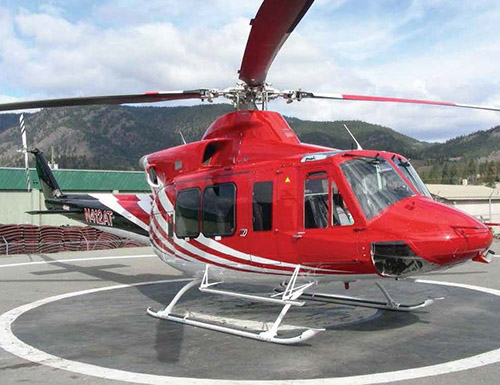
Nestled in the heart of the Okanagan Valley, otherwise known for its wineries, golf courses and ski hills, is Alpine Aerotech in Kelowna, British Columbia. Alpine Aerotech is a Bell Helicopter Platinum-Level Customer Service Facility (CSF) that has developed its business over the past 23 years based on a few simple principles: technical expertise, quality workmanship and delivering what it promises.
This philosophy seems to be working — Alpine Aerotech has grown from three employees and 4,200 square feet in 1990 to 100 employees and 64,000 square feet in 2013, with another 18,000 square feet being added this summer. To highlight its principle of technical expertise, all department managers have been with the company for more than 10 years and have, on average, more than 25 years of industry experience each.
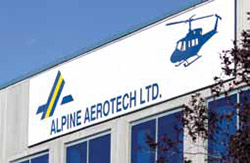 This experience level was nudged upward when vice president Jim Campbell was recruited in 2011 to run and grow the business. Campbell has a 44-year history in aviation, from field maintenance on Bell, Sikorsky and Eurocopter helicopters, to running various shops and businesses. He has been involved with the expansion of a number of companies including Associated Helicopters, ACRO Aerospace, Helipro Component Services (for which he and Mike Druet won the Entrepreneur of the Year Award in 1999 for the Pacific Region Emerging category), and CHC/Heli-One.
This experience level was nudged upward when vice president Jim Campbell was recruited in 2011 to run and grow the business. Campbell has a 44-year history in aviation, from field maintenance on Bell, Sikorsky and Eurocopter helicopters, to running various shops and businesses. He has been involved with the expansion of a number of companies including Associated Helicopters, ACRO Aerospace, Helipro Component Services (for which he and Mike Druet won the Entrepreneur of the Year Award in 1999 for the Pacific Region Emerging category), and CHC/Heli-One.
Campbell is now into his third year at the helm and the growth and success of the business has caught the attention of its owners (Intrawest, a holiday resort developer whose foray into helicopters began with the acquisition of Canadian Mountain Holidays, the largest heli-skiing operation in the world; and its parent, the Fortress Investment Group LLC, based in New York).
“When they recruited me, they wanted me to be 10 years younger, so I told them I would give them three years and then help them find a successor,” jokes Campbell.
However, after a great first year, the CEO of Intrawest called him up and said, “Forget the three years. I want as many years as you can give me — just give us a 12-month notice when you want to retire.”
Campbell’s mandate now involves some serious growth plans, but he is quick to add, “Whatever we may do in the future to expand, we will ensure our core principles are embedded, and our customers always come first.”
Shop capabilities
“Just about everything you can do to a Bell Helicopter, we can do,” advises Neil Baycroft, Alpine Aerotech shop general manager. Its capabilities include everything from routine to major maintenance checks and aircraft completions, avionics installations, repairs and aircraft re-wiring; a full service paint shop, a component overhaul shop with capability on just about every Bell model, a specialty welding shop and a growing composite repair shop.
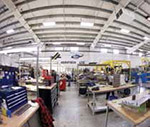
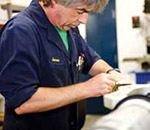
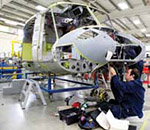
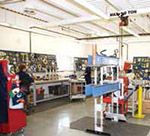
Alpine Aerotech specializes in structural repairs — everything from field sheet metal repairs to major fuselage and tailboom fixture or “jig” repairs. Not only does Aerotech own and use jigs, it is the largest manufacturer of Bell-approved fixtures, having made and sold more than 30 fuselage and tailboom repair fixtures for other shops around the world, including Bell Helicopter subsidiaries. In addition, Aerotech built to print the 407 and 427 production cabin splice fixtures for Bell Helicopter Canada’s aircraft production line.
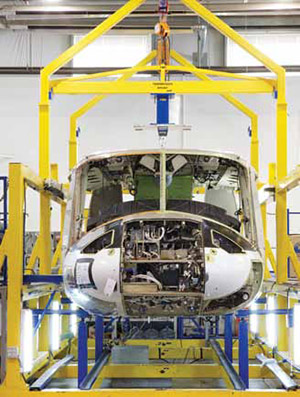 “Our engineering and manufacturing capabilities are a major differentiator between us and most other MROs”, says Campbell. In addition to airframe fixtures, Alpine Aerotech has a catalogue (available on its Web site) that showcases its engineering and manufactured products — everything from Bell 212/412 exhaust ejectors to a number of mission and operational convenience items. Some high-tech equipment, along with authorizations for some exotic welding and manufacturing techniques, allow Alpine Aerotech to manufacture high-quality items economically and right here in North America. Its maintenance expertise and helicopter operations background allow it to design improvements and innovation into everything it adds to its catalogue.
“Our engineering and manufacturing capabilities are a major differentiator between us and most other MROs”, says Campbell. In addition to airframe fixtures, Alpine Aerotech has a catalogue (available on its Web site) that showcases its engineering and manufactured products — everything from Bell 212/412 exhaust ejectors to a number of mission and operational convenience items. Some high-tech equipment, along with authorizations for some exotic welding and manufacturing techniques, allow Alpine Aerotech to manufacture high-quality items economically and right here in North America. Its maintenance expertise and helicopter operations background allow it to design improvements and innovation into everything it adds to its catalogue.
“We’ve always had a great relationship with Bell helicopters, and that is what lead to our expansion in the manufacturing side of the business,” says Campbell. “We went to them asking ‘Where can we help you?’ As a result, we are manufacturing a number of parts for them, which are included in the Bell illustrated parts catalogue and are on new manufacture of aircraft like the 412s.”
Shop specialties
When pressed to name one key specialty that Alpine Aerotech is known for, Campbell offers, “If I had to narrow that down to one specialty, it would have to be taking a worn, tired, or bent and broken helicopter and making it ‘new’ again. By that I mean bringing it economically back to ‘like new’ condition, and adding any customer desired upgrades or additions along the way. To do this well, we have to rely on all of our individual specialties and expertise, so it’s one specialty, and it’s all of them, too.”
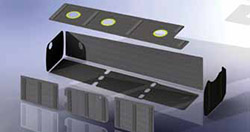
To make it new again, Alpine Aerotech follows a tried and true process. Whether it’s an older, worn helicopter that is coming due for a major inspection, or if it has had a mishap and needs rebuilding, the first step, which starts well before the aircraft comes through Alpine Aerotech’s door is preparing a workscope and cost estimate for the customer. Where possible, it will send an engineer to view the aircraft. If that is not possible, Alpine Aerotech will request photos and a detailed description of condition and any damage.
Finding new business
While there are different approaches that MROs use to land business, Alpine Aerotech staff prefers to provide a realistic assessment right up front, rather than a “low bid” with bad news to come later. Some customers request a bid against a specifically-defined workscope that is often inspection only, to allow them to compare different bids on an apples-to-apples basis. In this case, Alpine Aerotech will comply with the request and will provide additional information including the likely total cost after inspection or historical averages for helicopters with similar workscopes, to ensure the customer knows the full story. “We’re not here to get one job in the door. We’re here to make happy customers at the end of the job — to earn their respect and repeat business,” says Campbell.
Alpine Aerotech has established a strong reputation as a high-quality service provider to Bell Helicopter operators and has achieved a high level of repeat customers and referrals. In 2009, Bell Helicopter honored Aerotech by designating it a Platinum-Level Customer Support Facility (CSF). At that time, it was the only Canadian CSF so recognized and one of only six companies worldwide to achieve this distinction. Alpine Aerotech has continued to achieve Bell’s Platinum-Level rating every year since.
Disassembly and more
The next phase is aircraft arrival, disassembly and detailed inspection. The level of disassembly is dependent upon a few things, including the requirements of any scheduled maintenance check (the major maintenance check on the Bell 212/412 is a 3,000 hour/five-year inspection), any specific damage that needs repair, service bulletins, modifications or upgrades that are requested or required, and damage or corrosion that is found during the inspection.
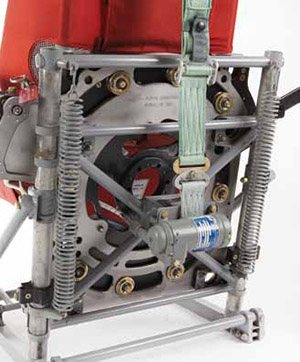
Alpine Aerotech puts emphasis on customer communication during this phase, and provides the customer with options to consider to reduce costs and/or enhance the end product. Options could include rework or refurbishment rather than replace parts, remanufactured panels rather than new, additional upgrades or optional repairs.
“Customer involvement here is key,” says Campbell. “They need to be part of the decision-making process to ensure that the end result will best fit their needs as well as their pocket-book.”
New parts are expensive, so if a worn part can be repaired, reworked or exchanged for a remanufactured part, and the integrity of the part is not compromised (and in many cases is enhanced), most customers will request it. Alpine Aerotech’s long list of manufactured items, such as exhaust ejectors, other exhaust components and a number of airframe panels, and its ability to repair and rework these parts, allows it to provide cost-effective solutions on these items. In addition, when composite panels need replacement, many customers will opt for aftermarket remanufactured panels that provide additional savings.
Completing the work
The next phase involves carrying out and completing the work. Alpine Aerotech’s expertise at project management comes into play to ensure efficient use of resources and meeting the customer’s schedule. “Delivering on time goes a long way to making a customer happy, so we take our turnaround time and delivery commitments very seriously,” says Baycroft, who oversees major projects that involve a number of Alpine Aerotech shops.
A key capability on major refurbishment projects is Alpine Aerotech’s avionics shop. There has been a revolution in avionics technology during the last 20-30 years, and many customers are ready to upgrade to the new flat panel and solid-state technology that improves both performance and reliability. Alpine Aerotech can provide STCs on new installations. Additionally, partial or complete rewiring is often requested on older aircraft, and Alpine Aerotech’s efficient wiring harness manufacturing and laser wire marking make rewiring a cost-effective offering.
Another key capability that comes into play in the completion phase is Aerotech’s refinishing and paint shop. “When re-painting is required, having this capability in-house is essential. It allows us to control both quality and schedule, as some parts are painted in conjunction with other completion work, rather than doing everything at the end.” Aerotech works with customers to help them create a new paint scheme or use their established scheme. Paint is more than just cosmetic — it is a first layer of protection against corrosion and the elements. Alpine Aerotech is equipped with pressure- and temperature-controlled paint booths to facilitate quality coating applications consistently. One 58-feet-long, 16-feet-wide, 20-feet-high booth can accommodate a complete medium-sized Bell helicopter, with another (30-feet-long, 14-feet-wide, 9-feet-high booth for fuselages, tailbooms or smaller components.
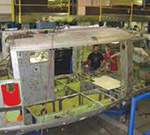
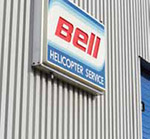
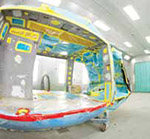
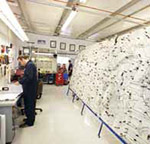
Alpine Aerotech utilizes plastic media blasting (PMB) processes to remove old paints and fillers, leaving a clean surface devoid of any residues common with chemical removal techniques. This process is efficient and environmentally friendly.
Is there anything Alpine Aerotech doesn’t do? “Well, we don’t overhaul engines or hydraulics — not yet, anyway,” says Campbell. “We have our eye on some new OEMs and helicopter types that we’d like to duplicate our existing capabilities on.”
As Intrawest, Alpine Aerotech’s parent, grows its new aircraft leasing business into new helicopter types, it will look to Alpine Aerotech for support. “Looks like I won’t be retiring anytime soon,” laughs Campbell — and the helicopter MRO industry is all the better for it.
 Jim Campbell | Contributing Author
Jim Campbell | Contributing Author
